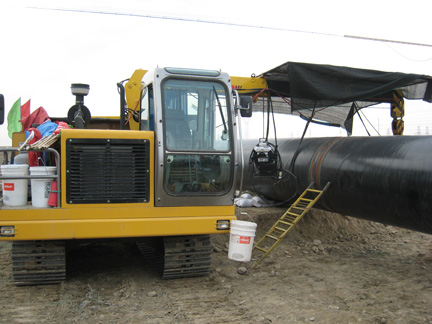Filler Metals for Welding Today’s (and Tomorrow’s) High Strength Pipe
As the world’s energy demands continue to grow and new sources of fuel are sought, it’s no surprise that contracting companies have begun to expand the use of stronger, more cost-effective materials to build longer and more remote pipelines—both onshore and offshore. Instead of X70 steel pipe, the standard in past years, material like X80 grade steel has become an increasingly common choice. This trend is especially prominent thus far in North America, China and Russia (K60 and K65) with other areas of the world following closely behind.
X80 steel pipe, which offers a minimum yield strength of 80,000 psi, provides definite advantages in terms of material cost, lay time, and overall operating cost; however, there are an equal number of challenges to using it. Not only do engineers have greater design obstacles compared to pipelines comprised of lower strength material, but the welding procedures, including filler metal selection, are also much more stringent. First, let’s consider the benefits.
The Advantages
The biggest advantage to X80 steel pipe is that despite its thinness—it generally ranges from 18- to 33-mm—it has excellent strength properties. These properties allow companies to build longer pipelines with greater carrying capacity, based on higher operating pressures, and can reduce the initial cost of steel for the entire project. Given that most contracting companies cite steel as about 50 percent of the total cost of a pipeline, thinner, less expensive material obviously can have a significant impact on the overall profitability of the job. The ability to operate at higher pressures also saves companies money by reducing the number of compressor stations required.
Likewise, this thinner material can reduce transportation costs. Since most of the projects using X80 or stronger pipe are located in remote areas, often of very rough terrain, reducing the weight of a material haul consequently reduces fuel consumption, along with wear and tear on trucks and trailers.But most importantly, from a construction point of view, using thinner walled, higher strength X80 steel pipe reduces labor costs associated with welding and helps decrease pipe lay time. Simply stated—thinner walled pipe requires fewer weld passes that can be completed in a shorter period of time. So with all these advantages, what’s the dilemma?
The Challenges
Due to its high yield strength, the addition of various alloys (manganese, copper, molybdenum and nickel among other) and a relatively low carbon base, X80 steel has an inherent susceptibility to hydrogen-induced cracking when welded. Not only that, but the pipelines that these materials comprise are almost always subject to extreme environmental conditions—to temperatures as low as -60 degrees Fahrenheit (-51 degrees Celsius).
As such, pipeline engineers must design X80 pipelines to withstand the impact of thermal expansion or contraction, frost and/or other environmental loadings without damaging the steel—or the welds. The design must further accommodate the high operating pressures for which most new pipelines are intended. These factors have resulted in another emerging trend in pipeline projects: a strain based design. While effective, this type of design places further challenges on the welding portion of these projects.
In addition, X80 steel pipe is simply more difficult to weld than lower strength materials. Welding procedure variables such as pre-heat and interpass temperatures, along with the overall welding parameters (amperage, voltage, etc), are much more stringent and must be very carefully observed. For that reason, having skilled, properly trained welding operators is absolutely critical.
Finally, the filler metals used to weld X80 steel must meet the material’s strength requirements, provide the ductility to resist cracking and compensate for the extreme temperatures to which these pipelines are subject. Whereas standard cellulosic stick electrodes, including AWS E6010 and E9010, have been suitable for root passes and/or tie-in welds on the previous generation’s X70 steel pipelines, they are less appropriate for higher strength material like X80 steel. They are not as capable, chemically or mechanically, to mitigate the risk of hydrogen-induced cold cracking, nor are they conducive to the high level of productivity required to complete such large pipeline projects. With that in mind, the transition to using tubular welding wire has become a natural development in recent years.
The Solutions
To date, several X80 pipelines worldwide have used flux-cored wires in place of or in addition to low-hydrogen cellulosic stick electrodes in order to address the challenges of welding X80 steel pipe. One such project is the Cheyenne Plains Pipeline Project completed in 2005 and the first in North America to be constructed of X80 steel. Contracting companies there relied on AWS E101K2 gas-shielded flux-cored wire for the fill and cap passes on a portion of the project. Another North American pipeline project currently being constructed, the 1,663-mile long Rockies Express (REX) pipeline uses both gas- and self-shielded flux-cored wires for its fill and cap passes as well. The West–East II in China is also using flux-cored wires for a majority of the project to decrease lay time, reduce labor costs, and meet the chemical and mechanical properties of the X80 material.
Using self-shielded flux-cored wire, in particular, has added significantly to the costs savings sought on these and similar X80 pipeline projects: it offers faster, easier set-up and does not require extensive protection tents to shield the welds. Plus, filler metal manufacturers have been able to develop formulas that provide welds with hydrogen levels lower than 8.0-ml/100 g (compared to the average 30.0 to 40.0-ml/100g available with stick electrodes) to further reduce the chance of cracking. The AWS E81T8-Ni2 J wire is one such product that has begun to be used to weld X80 steel pipe.

flux-cored and metal-cored wires are becoming popular filler metals
for welding X80 grade steel pipe.
This classification of wire contains less than 8.0-ml/100g of diffusible hydrogen and offers tensile strengths in the range of 80,000 to 100,000 psi with 19 percent elongation. CVN impact values are approximately 20 ft•lbs at -20 degrees Fahrenheit (-29 degrees Celsius) in the as welded condition and the wire offers 82,000-psi minimum yield strength for an equal match to X80 steel pipe in the vertical down procedure. It is used for the fill and cap passes, making it a significantly more efficient alternative to traditional stick welding. In addition, the ‘J’ designation ensures the wire has been stringently tested and offers results at -20 Fahrenheit lower than the specified temperature. Other wires labeled under the ‘G’ class do not; these wires instead meet a ‘general’ classification, which is simply an agreed upon specification between the supplier and purchaser. It is not guaranteed to provide the exact properties needed for X80 steel pipe.
Still, these ‘G’ class wires have their place and the AWS E101T1-GM gas-shielded flux-cored type, for example, has proven successful to weld X80 steel pipe under certain circumstances.There are three major reasons for the success of welding X80 steel with these types of flux-cored wires: high strength properties, low hydrogen content and easy operator training. They are not, however, the only type of filler metal that is beginning to replace and/or complement low-hydrogen cellulosic stick electrodes as the product of choice for X80 steel pipe welding. Another is metal-cored wire.
Metal-cored wires are starting to replace stick electrodes primarily for root pass welding. Thus far, contractors have confirmed it is easy to train welding operators to use these wires and they can also speed pipe lay time due to the fact that metal-cored wires offer higher deposition rates. Many contracting companies are pairing metal-cored wires with a welding process called Regulated Metal Deposit or RMD™. The RMD process controls the short circuit during the welding process to create consistent and uniform metal transfer from the wire and is designed for root pass welding. It has proven to be a very robust root welding process and has helped to expedite operator training on projects like the West-East II. Metal-cored wires can, in some circumstances, be used to create welds from start to finish.
In addition to using metal-cored wire and RMD for root passes (and flux-cored in some areas), portions of the West–East Gas Pipeline II have also employed AWS E80C-Ni1 metal-cored wire for the root, fill and cap passes. This type of wire provides tensile strengths ranging from 85,900 to 90,000 psi (using 98 percent Argon/2 percent O2 or 75 percent Argon/25 percent CO2, respectively), along with CVN properties of 46 ft•lbs to 56 ft•lbs at -50 degrees Fahrenheit (-46 degrees Celsius). It has also improved productivity on this portion of the project, as there is no need to change out filler metals for each pass. Further, there is minimal interpass cleaning required since metal-cored wires do not produce slag like flux-cored wires or stick electrodes.
The Future
As the pipeline industry uncovers new sources of energy, the transition to materials even stronger than X80 seems inevitable. In fact, it’s not uncommon already to see X100 steel making an appearance in offshore projects, and some experimental onshore projects, that are exposed to extreme environmental and operating conditions. Equally probable is that the limits of welding—and especially filler metal technology—will continue to be challenged, with this initial transition from low-hydrogen cellulosic stick electrodes to flux-cored and metal-cored wires indicating just the beginning of changes to come.
This article was originally published in the July 2009 issue of World Pipelines (copyright Palladian Publications).



